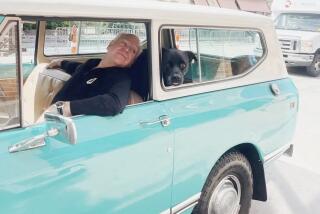Saturday Drive: The designer behind Aston Martin’s V-12 Zagato
The car: Aston Martin V-12 Zagato
The power: 510 horsepower and 420 pound-feet of torque from a 6.0-liter, quadruple-overhead camshaft V-12 engine.
The speed: 0-60 in 4.2 seconds
The photos: Aston Martin V-12 Zagato
The bragging rights: Although no lighter or more powerful than the V-12 Vantage upon which this car is based, it is much more rare; production will be limited to just 150 units worldwide. The body panels are made from carbon fiber and handcrafted aluminum and are exclusive to the V-12 Zagato.
The price: A not insignificant 330,000 pounds. Not in the United Kingdom? That’s roughly $524,000, based on current exchange rates.
The details: The exceptionally high price indicates exclusivity and likely a hope that this V-12 Zagato’s status as a collector’s item follows that of the car that served as its inspiration, the DB4 GT Zagato. Less than two dozen copies of that car were made in 1961, with only a handful destined for road driving (the bulk were for racing). Existing models today are worth several million dollars.
That ‘Zagato’ moniker refers to the Italian coachbuilding company that has modified the designs of numerous automakers since its inception shortly after World War I. Brands including Ferrari, Alfa Romeo and Aston Martin have Zagato derivatives. Initially used for race variants, Zagatos from the past 20 to 30 years are usually commissioned individually by wealthy car collectors or the automakers themselves. Nothing is more depressing than parking your new Ferrari at Port Hercules in Monaco, only to find the guy with the slip next to you bought the same car.
But this V-12 Zagato was much more of a collaboration between Zagato and Aston Martin, and indeed, it was penned by none other than Aston Martin’s own director of design, Marek Reichman. If the name doesn’t mean anything to you, his work should; it was he who designed other notable Aston Martin cars including the DBS, the Rapide and the One-77 supercar.
In a phone interview from his design studio at Aston Martin’s Gaydon headquarters in Warwickshire, England, Reichman said the V-12 Zagato was first discussed between himself, current Zagato Chief Executive Andrea Zagato and the head of Aston Martin, Dr. Ulrich Bez, at the 2010 Geneva Motor Show. The trio knew 2011 would be the 50th anniversary of the now-iconic DB4 GT Zagato, and they wanted to do something to commemorate it.
Reichman said he began sketching immediately.
Several weeks later, designers from Zagato and Aston Martin held sort of a mini-competition to see which design they liked best. The Aston Martin group’s design, led by Reichman, was selected. He said this was because the winning design balanced the history of the DB4 GT Zagato, with hints towards what future Aston Martin designs may look like.
“From an Aston Martin perspective, we saw this as, yes, celebrating the past 50 years but also our potential for the next 50 years,” Reichman said.
“This was never just a literal translation of something. The DB4 GT Zagato was wonderful...it was very powerful, muscular, dramatic and brutal, but it had an elegance to it, a simplicity. It always had this beautiful brutality to it, and we wanted the new car to embody that,” he said.
Reichman said key design elements of this V-12 Zagato include the “very pure, yet dramatic form” of the rear of the car, the harder lines down the side of the car and over the rear fenders, the blackened-out A-pillar and the cut and chopped roof. Note too, that in keeping with Zagato tradition, this V-12 Zagato has the “double bubble” roof originally used on early Zagatos to allow headroom for the racers’ helmets.
His favorite element of the car? “The drama of the window graphic as it cuts through the car. It’s a dramatic line, and really makes the car very low to the ground, very squat, very powerful. When you look at the car from the back, it looks like a viper [the snake, not the car]. It has a very menacing look to it,” Reichman said.
When asked if there was any pressure working on one car that celebrates another with such a storied past, Reichman simply laughed.
“It’s been hard enough since I’ve been (with Aston Martin); we did the company’s first four-door (the Rapide, read our review here), the first super car (the One-77) and the first Bond car (the DBS, which heralded Aston Martin’s return to the films). There are all kinds of pressures at this job. I always see them as opportunities, never as a challenge,” Reichman said. “The team here sees themselves as ambassadors of Aston Martin. The designs here have had such longevity, we want to repeat the same now.”
At the moment, though, this car is his favorite design. Reichman likens it to one’s children; while the first child (the DBS) will always have a special place in his heart, he says the one you just gave birth to is in the mind’s eye the most.
“It’s so fresh in your mind, it’s wonderful,” Reichman said. His tone indicated a man clearly lost in appreciation for the car.
One-hundred-fifty people will find out just how lost one can get.
More to Read
Inside the business of entertainment
The Wide Shot brings you news, analysis and insights on everything from streaming wars to production — and what it all means for the future.
You may occasionally receive promotional content from the Los Angeles Times.










